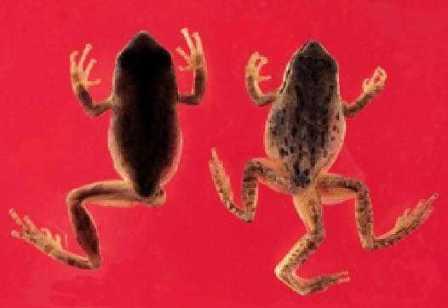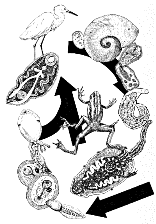 |
Experimental Design Adapted
from the FIRST II Project (www.first2.org)
Images from http://info.hartwick.edu/biology/def_frogs |
Goals:
Objectives: Students will be able to
|
| At this point in your science education, you may or may not have had much experience with scientific methodologies. The purpose of these activities are to give you experience with experimental design, which is a key component of scientific inquiry. You already started designing experiments through your organismal and ecological research projects. You will further develop your understanding and skills in this activity so that you are prepared to design more extensive experiments in subsequent activities. Rather than conducting your own research, you will begin by studying investigations of an unusual phenomenon concerning amphibian deformities. |
 |
| PART A. What's going on with frogs? Since 1980, over 40% the world's estimated 6,260 amphibian species are threatened or extinct in almost every part of the world, even in protected wildlife reserves and parks. In some locales, frog deformities (such as extra legs and missing legs), which usually lead to mortality, are occurring in unusually high numbers. Imagine that you found the frogs pictured above in a pond on your property. On further investigation, you discovered that over 30% of frogs in that pond have similar deformities. How will you determine what caused the deformities? |
| Think
INDIVIDUALLY for a minute. Now brainstorm with your group. EXPLORE: Solve the deformed frog problem. This is a group problem, but each individual is to record everything in his/her notebook. Select a recorder for your group. The recorder is to turn in the group responses to questions marked with an asterisk (*). Be sure to include the group name, and names of the group members. In your group, discuss and list possible causes of the frog deformities. Consider both biotic and abiotic variables (5 min) |
| Scientists working on the
question of frog deformities have proposed several possible causes, four of which are
Each group has data related to each predicted cause of frog deformities. These data are based on compilation of results from several experiments, and represent actual trends in current research findings.  Data sheets: Each individual in your group studies one of the four data sheets.
Groups: Review each possible hypothesis and design with each other (5 min). *Recorder:
Record the four hypotheses.
Each individual in the group (who is now an expert on one experiment) does the following:
*Recorder: Write your group's responses (5 min). |
| EXPLAIN: Does
the conclusion from the research explain the increased frequency of frog
deformities in your pond? Think about this and then discuss your ideas with your group members. For example, below are questions to consider if you studied the the effects of trematodes. Pose similar questions for the other data sets to help you determine any effects of each variable studied. 
*Recorder: Include key points of the discussion in
your group report (5 min).
|
| FURTHER
EXPERIMENTATION: Synergistic effects of two variables. Hypothesis: The effects of atrazine and trematodes together on the proportion of frogs that exhibit deformities are greater than the effects of either atrazine or trematodes alone. Experimental Design: 
Results:
Data estimated from Figure 1 in:
Kiesecker JM.
2002. Synergism between trematode infection and pesticide exposure: A
link to amphibian limb deformities in nature? Proc. Nat. Acad. Sci.
99(15): 9900-9904. Discuss
the results in your group. *Recorder:
In one sentence, interpret the results in the context of the stated
hypothesis. Use the header: |
FOR FURTHER THOUGHT: What are the implications of these results on human health? What are your predictions?
|
 PART
B. The Frog Pond Tutorial PART
B. The Frog Pond TutorialNext you will further investigate frog deformities using a simple simulation to conduct experiments. Simulations do not replace real experiments. Rather, simulations are a valuable educational tool because they allow you to conduct multiple experiments in a much shorter period of time than if you were working in the field or laboratory. In the Frog Pond simulation, you will investigate whether genetic or environmental factors cause variation among individual frogs. Your Professor will provide you with instructions for using the Frog Pond Tutorial, which is located in your course manual. |
 PART
C. Understanding Experimental Design PART
C. Understanding Experimental DesignLearning to conduct scientific experiments that are rigorous in their design and provide reliable evidence that supports or fails to support a hypothesis(es) takes practice. You probably already have some experience with experimental design from high school. As you are already aware, designing experiments is a critical component of this course. Here you will review the basics and expand your expertise in experimental design. You will use a simulated disease system and personalized feedback to overcome any confusions you still have about experimental design. You will reinforce the skills you are developing in experimental design and summarizing and interpreting experimental results. The main concepts that you will study here are systematic variation, control treatments, replication, and scope of inference. Follow the instructions provided by your professor and complete the Understanding Experimental Design module. |